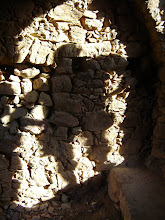Today I went for an afternoon walk on the Yorkshire Wolds, close to the village of Warter. The village is typical of many in this rural region of East Yorkshire, but it has recently achieved some renown, the surrounding countryside having received the attention of world-famous artist David Hockney. In the late 90's, Hockney, if nothing an innovative artist, returned to his native county to paint landscapes. As some of the 360-degree panoramas I enjoyed today bear witness, landscapes here can be quite expansive. Equally expansive are the paintings that Hockney has created to depict some of the views here: Bigger Trees Near Warter, one of these paintings, is made up of 50 smaller canvases, adding up to an area 12 metres by 5 metres high. The landscapes here may well be sweeping, but they can be dynamic too as I found later when I walked across Nunburnholme Wold. Hockney's winter and summer views of the beech copse here are a little more modest in size, at 3m x 4m. It was Hockney's intention to reproduce the self same scene in spring and autumn, but when he returned in March this year, he found a scene of devastation. The copse had been felled for its valuable timber. Nothing remains but an empty sky (see above).
For more information: The fallen beech trees and the lost canvas.
Another interesting oddity of this afternoon's outing was the discovery of the Kipling Cotes racecourse, said to be the venue for the oldest horserace in England
Another interesting oddity of this afternoon's outing was the discovery of the Kipling Cotes racecourse, said to be the venue for the oldest horserace in England











